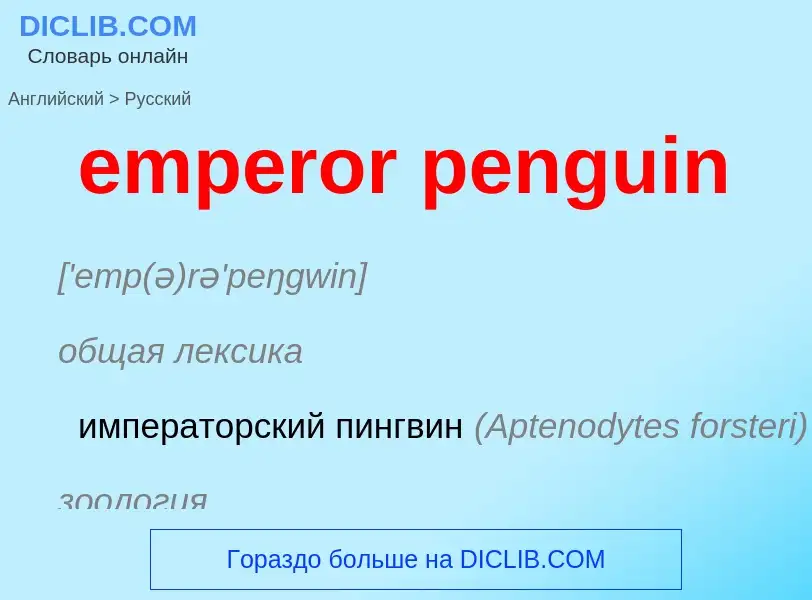Translation and analysis of words by ChatGPT artificial intelligence
On this page you can get a detailed analysis of a word or phrase, produced by the best artificial intelligence technology to date:
- how the word is used
- frequency of use
- it is used more often in oral or written speech
- word translation options
- usage examples (several phrases with translation)
- etymology
emperor penguin - translation to russian
['emp(ə)rə'peŋgwin]
общая лексика
императорский пингвин (Aptenodytes forsteri)
зоология
императорский пингвин (Aptenodytes fosteri)
общая лексика
очковый пингвин (Spheniscus demersus)
Смотрите также
Definition
Wikipedia

The emperor penguin (Aptenodytes forsteri) is the tallest and heaviest of all living penguin species and is endemic to Antarctica. The male and female are similar in plumage and size, reaching 100 cm (39 in) in length and weighing from 22 to 45 kg (49 to 99 lb). Feathers of the head and back are black and sharply delineated from the white belly, pale-yellow breast and bright-yellow ear patches.
Like all penguins, it is flightless, with a streamlined body, and wings stiffened and flattened into flippers for a marine habitat. Its diet consists primarily of fish, but also includes crustaceans, such as krill, and cephalopods, such as squid. While hunting, the species can remain submerged around 20 minutes, diving to a depth of 535 m (1,755 ft). It has several adaptations to facilitate this, including an unusually structured haemoglobin to allow it to function at low oxygen levels, solid bones to reduce barotrauma, and the ability to reduce its metabolism and shut down non-essential organ functions.
The only penguin species that breeds during the Antarctic winter, emperor penguins trek 50–120 km (31–75 mi) over the ice to breeding colonies which can contain up to several thousand individuals. The female lays a single egg, which is incubated for just over two months by the male while the female returns to the sea to feed; parents subsequently take turns foraging at sea and caring for their chick in the colony. The lifespan is typically 20 years in the wild, although observations suggest that some individuals may live to 50 years of age.


![colony]] on [[Snow Hill Island]] colony]] on [[Snow Hill Island]]](https://commons.wikimedia.org/wiki/Special:FilePath/2007 Snow-Hill-Island Luyten-De-Hauwere-Emperor-Penguin-03.jpg?width=200)
![Mounted skeleton at the [[American Museum of Natural History]] Mounted skeleton at the [[American Museum of Natural History]]](https://commons.wikimedia.org/wiki/Special:FilePath/Aptenodytes forsteri (1).jpg?width=200)
![Emperor penguin attacked by a [[leopard seal]] Emperor penguin attacked by a [[leopard seal]]](https://commons.wikimedia.org/wiki/Special:FilePath/Fish8426 - Flickr - NOAA Photo Library.jpg?width=200)



![Two [[Adélie penguin]]s and an emperor penguin at [[SeaWorld San Diego]] Two [[Adélie penguin]]s and an emperor penguin at [[SeaWorld San Diego]]](https://commons.wikimedia.org/wiki/Special:FilePath/Penguins 2 bg 111602.jpg?width=200)

![USA]] USA]]](https://commons.wikimedia.org/wiki/Special:FilePath/African Penguin Skeleton.jpg?width=200)
![Nesting burrows of the African penguin, [[Boulders Beach]] (2017) Nesting burrows of the African penguin, [[Boulders Beach]] (2017)](https://commons.wikimedia.org/wiki/Special:FilePath/Bruthöhlen Brillenpinguin.jpg?width=200)
![African penguin at the [[Dallas World Aquarium]], [[Dallas]], [[Texas]], United States African penguin at the [[Dallas World Aquarium]], [[Dallas]], [[Texas]], United States](https://commons.wikimedia.org/wiki/Special:FilePath/Dallas World Aquarium January 2019 14 (black-footed penguin).jpg?width=200)




![African penguin part of the [[Betty's Bay]] colony African penguin part of the [[Betty's Bay]] colony](https://commons.wikimedia.org/wiki/Special:FilePath/African Penguin Betty's Bay.jpg?width=200)
